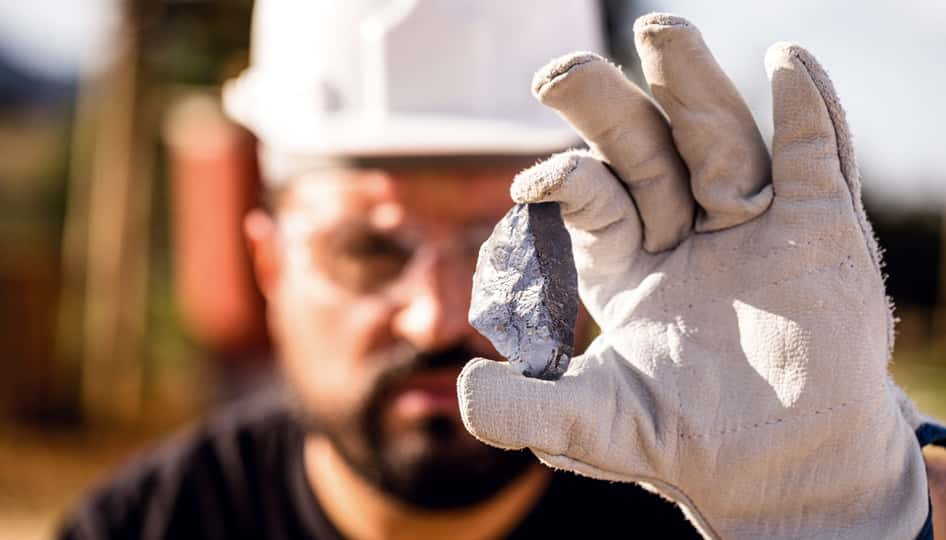With carbon emissions rising daily, the green mining industry now faces an urgent need to ensure ethical resource extraction. Companies are gradually adopting sustainable practices like green mining to reduce environmental impact and conserve resources for future generations, reflecting a shift toward eco-friendly operations in mining.
So, let us explore fundamentally sound stocks, Vale S.A. (VALE - Get Rating), BHP Group Limited (BHP - Get Rating), and Rio Tinto Group (RIO - Get Rating), which have successfully integrated green mining practices into their core operations, demonstrating a commitment to ethical resource extraction and sustainable environmental stewardship.
The mining industry is undergoing a major transformation this year as green mining practices gain traction. In response to growing environmental concerns and sustainability mandates, companies are adopting innovative strategies and technologies to minimize their ecological footprint and promote responsible, efficient resource extraction.
Emerging technologies are revolutionizing green mining by employing advanced machinery and techniques to minimize environmental impact. Automated drones, sensor-based sorting, and renewable energy sources are driving sustainability. These innovations pave the way for mining operations to reduce their ecological footprint and operate more efficiently.
Real-time monitoring systems enable mining operators to optimize resource extraction and reduce waste. Additionally, AI and machine learning facilitate smarter decision-making, improving operational efficiency while significantly cutting down the carbon emissions linked to traditional mining methods.
Looking forward, according to bccResearch, the global green mining market is expected to grow from $11.4 billion in 2023 to $16.9 billion by 2029, at a 7.4% CAGR.
Given this positive outlook, let us delve into the fundamentals of three leading green mining stocks, starting with #3.
Stock #3: Vale S.A. (VALE - Get Rating)
VALE, headquartered in Rio de Janeiro, Brazil, excels in the metal and mining sector, focusing on iron ore and nickel production. It also manufactures iron ore pellets, copper, platinum group metals (PGMs), gold, silver, and cobalt. The company functions through its Iron Solutions and Energy Transition Materials segments.
On October 18, VALE announced a strategic alliance with Petróleo Brasileiro S.A. – Petrobras (PBR - Get Rating) to supply competitive products and advance the decarbonization agenda. This agreement enables testing and marketing of three products: co-processed diesel with renewable content, natural gas, and bunker fuel containing 24% renewable content.
The partnership underscores VALE’s dedication to decarbonizing operations and assisting customers in reducing emissions. By leveraging Brazil’s advantages in renewable fuels, VALE is positioning itself strategically within the market.
In the fiscal third quarter, VALE reported record iron ore production of 91.0 million tonnes, marking a 5% increase year-on-year. The company also raised its 2024 production guidance to 323-330 million tonnes, up from the previous estimate of 310-320 million tonnes. Such figures reflect VALE’s commitment to operational excellence and growth in critical commodities.
Copper ore processed at Salobo 1 and 2 surged by 30% year-on-year, driven by improved mill performance. Additionally, the Sudbury mines contributed to a 20% increase in nickel mill throughput. VALE’s focus on operational stability and asset reliability continues to ensure sustainable growth and profitability.
VALE’s net operating revenue for the fiscal second quarter ended June 30, 2024, grew 2.6% year-over-year to $9.92 billion. Its operating income rose 34.7% from the prior year’s quarter to $3.88 billion. Additionally, net income and earnings per share attributable to VALE’s shareholders were $2.77 billion and $0.65, up 210.4% and 225% year-over-year, respectively.
Analysts expect VALE’s revenue for the fiscal year ending December 2025 to increase 3.2% year-over-year to $40.33 billion. Its EPS for the same period is expected to rise 7% from the prior year to $2.13.
Over the past month, shares of VALE have gained 2.8%, closing the last trading session at $10.57.
VALE’s promising outlook is reflected in its POWR Ratings. It has an overall rating of B, equating to a Buy in our proprietary rating system. The POWR Ratings assess stocks by 118 different factors, each with its own weighting.
VALE has an A grade for Value and a B for Quality. Within the Industrial – Metals industry, it is ranked #9 out of 29 stocks.
To see VALE’s ratings for Growth, Momentum, Stability, and Sentiment, click here.
Stock #2: BHP Group Limited (BHP - Get Rating)
BHP, based in Melbourne, Australia, specializes in producing various commodities, such as iron ore, copper, nickel, potash, and metallurgical coal. It actively engages in mining, smelting, and refining nickel and developing potash. The company operates through its Copper; Iron Ore; and Coal segments.
On October 7, BHP signed a memorandum of understanding with Steel Authority of India Limited (SAIL), the largest government-owned steel producer in India, to support steelmaking decarbonization.
The collaboration focuses on promoting lower-carbon steelmaking technologies, highlighting BHP’s commitment to sustainability. By advancing these practices, BHP can strengthen its global market presence and align with the increasing demand for greener steel products.
BHP has begun the 2025 financial year with impressive momentum, recording increased production across all major commodities for the quarter. Copper production rose by 4%, driven by higher grades and improved recoveries at Escondida.
Additionally, Western Australia Iron Ore (WAIO) production increased by 3% as the company unlocked capacity following the completion of debottlenecking work at the port. The company also observed signs of stabilization in its steelmaking coal sector, with production surging by 20% in the quarter, excluding the recently divested Blackwater and Daunia mines.
This overall growth reflects BHP’s commitment to enhancing operational efficiency and adapting to market conditions, positioning the company for continued success in the mining industry.
For the fiscal year which ended June 30, 2024, BHP’s revenues increased 3.4% year-over-year to $55.66 billion. Its underlying EBITDA came in at $29.02 billion, up 3.8% from the previous year’s quarter. Moreover, underlying attributable profit and underlying earnings per ordinary share rose 1.8% and 1.7% from the previous year’s period to $13.66 billion and $2.70, respectively.
Street expects BHP’s revenue for the fiscal year ending June 2026 to grow 1.9% from the previous year to $50.32 billion. Meanwhile, its EPS for the same period is expected to increase 5.2% year-over-year to $4.43.
The stock has gained 4.7% over the past month to close the last trading session at $56.32.
BHP’s strong fundamentals are reflected in its POWR Ratings. The stock has an overall rating of A, translating to a Strong Buy in our proprietary rating system.
It has an A grade for Quality and a B for Value and Stability. Within the same industry, BHP is ranked #3.
Click here to see BHP ratings for Growth, Momentum, and Sentiment.
Stock #1: Rio Tinto Group (RIO - Get Rating)
RIO, headquartered in London, United Kingdom, operates as a mining and metals company in 35 countries, producing iron ore, copper, aluminum, critical minerals, and materials essential for global energy transition. Its operations are categorized into segments including Iron Ore; Aluminum; Copper; and Minerals.
On October 9, RIO announced its acquisition of Arcadium Lithium, a global, fast-growing producer with long-life, low-cost operations and growth projects. This move is expected to enhance RIO’s lithium portfolio, aligning it with its aluminum and copper operations to support the energy transition and expand into essential materials.
By acquiring Arcadium, RIO would leverage its scale and financial strength to fully unlock the potential of Arcadium’s Tier 1 portfolio. With this strategic step, RIO is positioned to better meet the growing demand for lithium, securing long-term growth in the green energy sector.
On August 15, RIO announced a partnership with the Queensland Government to support Gladstone’s industrial base by investing in renewable energy. The collaboration secures the future of Boyne Smelters Limited (BSL), Australia’s second-largest aluminium smelter.
The agreement would enhance RIO’s reputation in the industry, help reduce operational costs, and align with global trends toward decarbonization, benefiting the company’s long-term growth.
For six months that ended on June 30, 2024, RIO’s consolidated sales revenue marginally increased year-over-year to $26.80 billion. Operating profit climbed to $8.26 billion, reflecting a 14% rise from the previous year’s quarter.
Furthermore, profit after tax reached $5.89 billion, and EPS hit $3.56, marking increases of 19.1% and 13.3% year-over-year, respectively.
Analysts expect RIO’s revenue and EPS for the fiscal year ending December 2024 to be $52.80 billion and $7, respectively.
RIO’s stock has gained 2.2% over the past month and 7.3% over the past year to close the last trading session at $64.95.
It’s no surprise that RIO has an overall rating of A, which equates to a Strong Buy in our POWR Ratings system.
RIO has a B grade for Value, Stability, and Quality. Out of 29 stocks in the Industrial – Metals industry, RIO is ranked #2.
Beyond what is stated above, we’ve also rated RIO for Growth, Momentum, and Sentiment. Get all RIO ratings here.
What To Do Next?
Get your hands on this special report with 3 low priced companies with tremendous upside potential even in today’s volatile markets:
3 Stocks to DOUBLE This Year >
Want More Great Investing Ideas?
BHP shares were unchanged in premarket trading Tuesday. Year-to-date, BHP has declined -13.13%, versus a 23.95% rise in the benchmark S&P 500 index during the same period.
About the Author: Aanchal Sugandh

Aanchal's passion for financial markets drives her work as an investment analyst and journalist. She earned her bachelor's degree in finance and is pursuing the CFA program. She is proficient at assessing the long-term prospects of stocks with her fundamental analysis skills. Her goal is to help investors build portfolios with sustainable returns. More...
More Resources for the Stocks in this Article
| Ticker | POWR Rating | Industry Rank | Rank in Industry |
| BHP | Get Rating | Get Rating | Get Rating |
| RIO | Get Rating | Get Rating | Get Rating |
| VALE | Get Rating | Get Rating | Get Rating |
| PBR | Get Rating | Get Rating | Get Rating |






